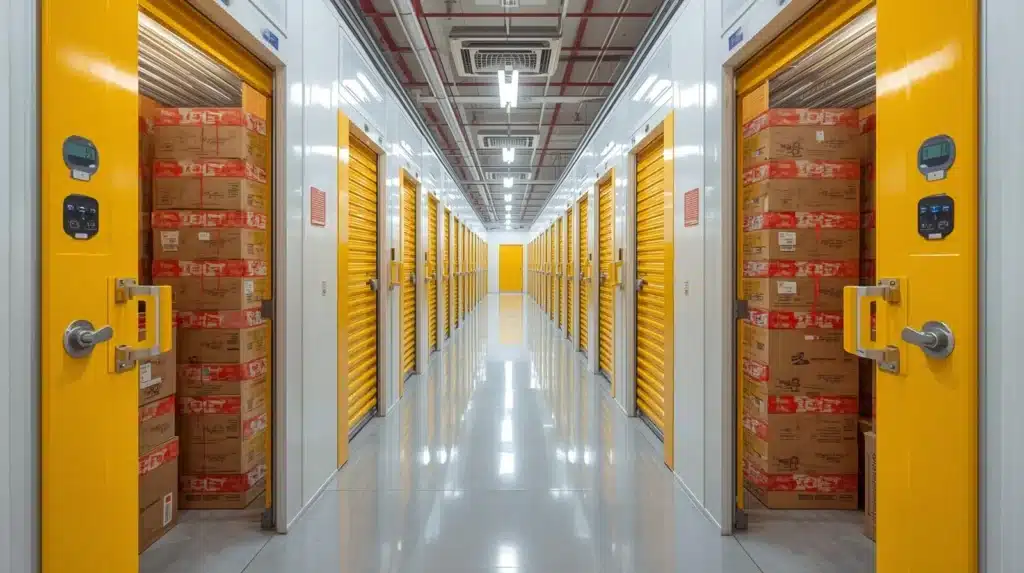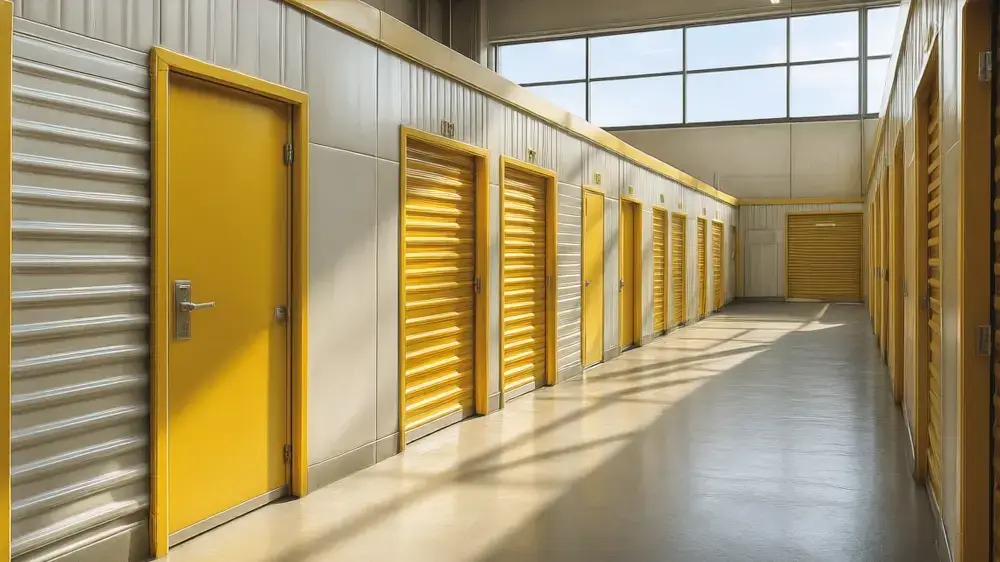If you live in the Emirates, you’re fighting three invisible enemies every summer: heat, humidity, and dust. That combo can warp wooden furniture, corrode electronics, yellow documents, grow mold on fabrics, and ruin the resale value of everything from handbags to musical instruments. In coastal cities like Dubai, Abu Dhabi, and Sharjah, daily highs often reach 40–45 °C, while humidity can surge to 70–90%.
Climate-controlled storage is not just a “premium” add-on; for many categories, it’s the only way to preserve function, appearance, and value in self-storage or storage units across the UAE. This guide provides a quick breakdown of what makes climate-controlled storage different and why it matters in hot, humid regions.
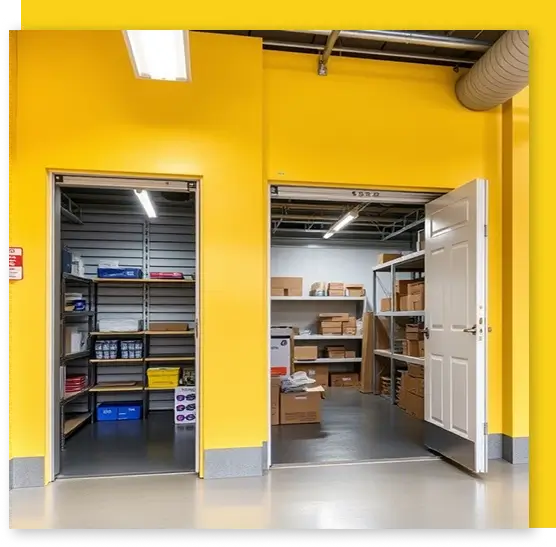
What Is Climate-Controlled Storage?
Climate-controlled storage keeps a unit within a reasonable indoor temperature range and regulates relative humidity. The goal isn’t just comfort—it’s to keep your belongings within safe environmental bands so they don’t swell, crack, mold, or corrode over time.
You should ask any storage provider to meet:
- Temperature moderation: Keeps the unit in a safe indoor range, instead of the heat-soak that happens in regular units.
- Humidity control: The big one for Gulf climates. Keeping RH under ~60% helps block mold and condensation.
- Consistent conditions: Stability (small daily swings) protects wood, paper, textiles, mixed collections, and electronics.
Bottom line: In self storage across the Emirates, climate control prevents the damage that shows up weeks later—cupped table tops, swollen guitar tops, failing batteries, sticky photo albums, and mildew in wardrobes.
Items Most at Risk (and Why They Need Climate Control)
Not all belongings handle Dubai’s heat and humidity the same way. Certain items are far more vulnerable, making climate-controlled storage essential to prevent costly damage.
Wooden furniture, antiques, veneers & parquet
Wood is hygroscopic—it absorbs and releases moisture with every humidity swing. In hot, humid conditions, cell walls swell, joints loosen, veneered surfaces lift, finishes haze, and drawers stick. In over-dry air, panels shrink and crack. That’s why museums keep wood in the ~40–60% RH band with gentle, stable temperatures. For heirlooms and antiques, climate-controlled storage units reduce expansion–contraction cycles that permanently stress glue lines and finishes.
Why climate-controlled storage matters:
Stable temperature and humidity keep moisture content in the safe zone, preventing warping, cupping, and veneer failure. In standard storage units, daily peaks (especially after sunset when outside RH spikes) push wood past its tolerance, so damage compounds week by week.
Local tip: Wrap with breathable cotton covers (not plastic), elevate pieces on pallets, and add desiccant packs inside drawers/boxes to buffer short spikes. Leave a small air gap between furniture and walls for airflow in self storage rooms.
Quick checklist:
- Inspect for loose joints and tighten hardware so movement doesn’t tear screw holes.
- Wax or oil finishes lightly to slow moisture exchange during storage.
- Do not shrink-wrap wood; plastic traps condensation in humid periods.
Musical instruments (pianos, guitars, ouds, violins)
Soundboards, bracing, and fingerboards are precision assemblies that react quickly to humidity. Outside ~40–60% RH, you’ll see fret sprout, top bellying, open seams, loose bridges, and unstable tuning. Glues can creep in heat, and finishes print or bloom in damp air. Climate-controlled storage keeps wood and adhesives in their comfort zone so instruments stay playable.
Why climate-controlled storage matters:
Even a few weeks of uncontrolled swings can introduce permanent geometry changes (neck relief, soundboard crown). In climate-controlled storage in Dubai or Abu Dhabi, RH stability protects both tone and structure.
Local tip: Case-store with a digital hygrometer and humidifier/dehumidifier packs; avoid leaving instruments on stands. For pianos, lock the fallboard, cover the instrument, and keep it away from direct AC supply grills.
Quick checklist:
- Loosen strings a quarter-turn on guitars/ouds for long storage; don’t fully detune.
- Use hard cases with silica packs; check RH cards monthly if you visit the unit.
- Keep rosin, oils, and cleaners sealed so fumes don’t imprint finishes.
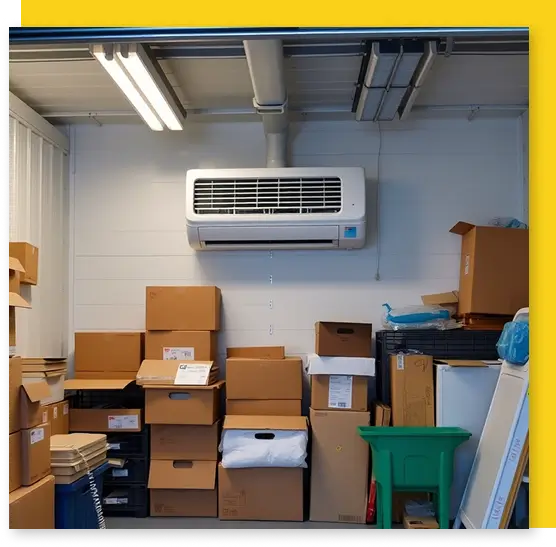
Electronics, appliances & lithium-battery devices
Humidity plus heat accelerates corrosion on contacts and PCBs; batteries swell when stored at high temperature or at 0/100% charge. Dust in desert environments is mildly hygroscopic and can wick moisture to boards. Manufacturer guidance consistently recommends a cool, dry place and ~50% state of charge for long-term battery health—conditions that climate-controlled storage provides. At the same time, standard units may exceed limits in summer.
Why climate-controlled storage matters:
Controlled RH curbs condensation on metal surfaces; lower, stable temperatures slow chemical aging in capacitors and batteries. That means a higher chance your device powers up cleanly after months in self storage.
Local tip: Back up data, remove loose batteries, and store devices at ~50% charge in original boxes with silica gel. Label cables and pack screens upright with foam corners inside climate-controlled storage units.
Quick checklist:
- Dust-seal bins, but include a desiccant; add an RH card to each tote.
- Avoid plastic wrap directly on metals; it can trap moisture.
- For fridges/freezers, defrost and dry completely.
Photographs, documents, books & archival records
Paper and photographic emulsions are extremely humidity-sensitive. Over ~60% RH, you risk mold growth, cockling, ink migration, blocked pages, and adhesive failures; heat accelerates yellowing and acid hydrolysis. Climate-controlled storage units with stable RH and temperature, plus acid-free enclosures, preserve both legibility and flatness.
Why climate-controlled storage matters:
Stability prevents dimensional change and reduces microbial activity. For passports, deeds, family albums, and corporate archives, climate-controlled storage is the difference between long-term readability and irreversible damage.
Local tip: Use acid-free folders/boxes, interleave photographs, and avoid tight plastic sleeves unless they’re archival-grade. For high-value archives, choose a unit that can log RH/temperature and place a small data logger inside your storage box.
Quick checklist:
- Remove paper clips, staples, and elastic bands that stain or cut.
- Store boxes off the floor, away from exterior walls and direct AC supply.
- Add buffer sheets (acid-free tissue) between prints and in book gutters.
Artwork, paintings, canvases & prints
Paint films, canvas fibers, and wooden stretchers all move differently with humidity, causing cracking, slackening, warping, and varnish bloom when RH and temperature swing. Light and ozone compound the problem. Climate-controlled storage keeps the microclimate stable so mechanical stress and surface reactions are minimized.
Why climate-controlled storage matters:
Stable ~40–60% RH and moderate temperature maintain tension and adhesion. In standard storage units, nighttime RH spikes can slacken canvases; daytime heat can print soft varnishes.
Local tip: Store artworks upright, not stacked; add corner protectors and spacers between frames and walls. Avoid AC drafts that create local cold spots and condensation.
Quick checklist:
- Use glassine or acid-free tissue as interleaves; avoid bubble wrap against paint.
- For glazed works, cross-tape glass to mitigate shatter risk.
- Record condition photos before storage for insurance and re-installation.
Fashion, leather goods & textiles (wedding dresses, abayas, handbags, shoes)
Protein fibers (silk, wool) and cellulose fibers (cotton, viscose) absorb moisture readily; dyes can bleed, finishes tack, and leathers mildew or crack. Heat accelerates oxidation and hydrolysis. Climate-controlled storage protects couture garments, bridal wear, abayas, handbags, and shoes from odor, mold, and shape loss.
Why climate-controlled storage matters:
Stable RH prevents microbial growth and keeps leathers supple; moderate temperature slows yellowing and plasticizer loss in trims. In self storage without control, sealed plastics trap moisture and speed damage.
Local tip: Use cotton garment bags, stuff handbags with acid-free tissue, and store shoes with shoe trees. Avoid long-term vacuum bags unless you add sorbents and plan periodic airing in a climate-controlled storage unit.
Quick checklist:
- Clean and fully dry garments before packing; soil feeds mold.
- Add activated charcoal or silica sachets into totes; replace quarterly.
- Keep boxes loosely packed to allow airflow; do not compress feathers/tulle.
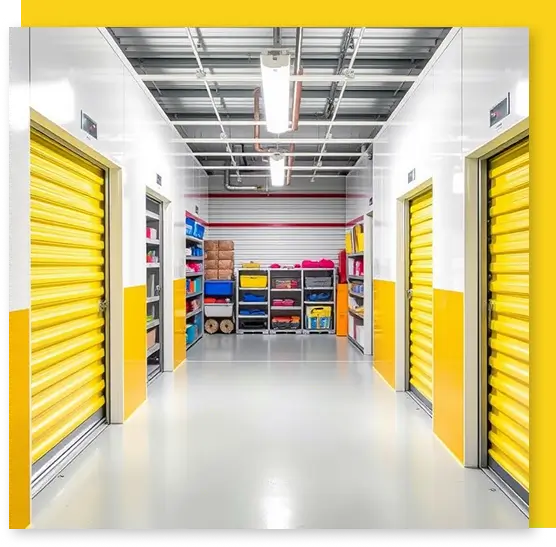
Cosmetics, skincare & general medical supplies
Many products specify “cool, dry place”—practically, controlled room temperature (~20–25 °C) with low humidity. Heat and moisture can separate emulsions, degrade actives, and weaken adhesives on sterile dressings. In summer, standard storage units often breach those limits; climate-controlled storage protects shelf life and customer experience if you hold inventory for a home business.
Why climate-controlled storage matters:
Temperature and humidity stability reduce phase separation and microbial growth. That preserves texture, scent, and efficacy—key for cosmetics and OTC supplies stored in storage units for weeks or months.
Local tip: Always follow the label. Items requiring 2–8 °C or 8–15 °C are not suitable for general self storage. Keep boxes upright, away from exterior walls; use opaque bins to limit light exposure.
Quick checklist:
- Group items by expiry date; store the oldest at the front for easy rotation.
- Seal liquids in double bags to contain spills during transport.
- Add a small min/max thermometer–hygrometer inside one bin and log readings when you visit the unit.
Vinyl records, audio tapes & CDs
Analog media are among the most sensitive to heat and humidity. Vinyl warps above ~30 °C, grooves distort, and jackets mildew in high humidity. Magnetic tapes (cassettes, VHS, reel-to-reel) shed oxide layers or suffer “sticky-shed syndrome” when stored damp, making playback impossible. CDs and DVDs delaminate or suffer disc rot under prolonged moisture swings.
Why climate-controlled storage matters:
Stable temperatures prevent vinyl warping, while controlled RH stops mold growth and adhesive failures in paper sleeves. In climate-controlled storage units, records and tapes keep their playback quality instead of degrading silently in standard self storage.
Local tip: Store records vertically, never stacked flat. Keep them in poly-lined inner sleeves and archival outer covers. For tapes, fast-forward and rewind fully once before storage, and pack upright in acid-free boxes.
Quick checklist:
- Avoid storing near AC vents or walls with direct heat exposure.
- Add silica gel packs to each box.
- Label boxes clearly for “This Side Up” to keep media aligned.
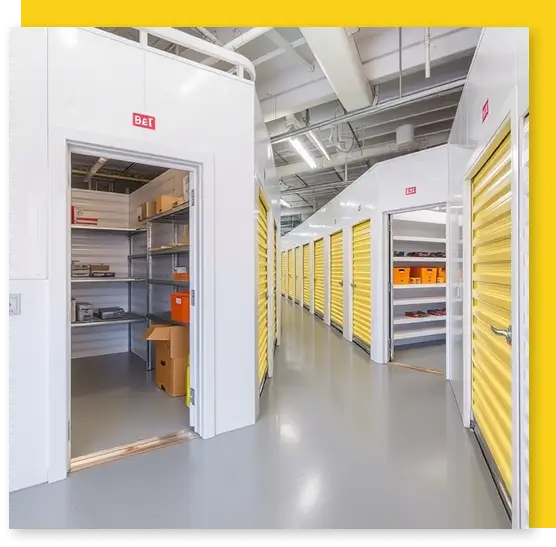
Fine rugs, carpets & textiles
Wool and silk rugs, Persian carpets, and embroidered tapestries are highly vulnerable to mold, moth larvae, dye migration, and fiber weakening when exposed to humid or dusty conditions. Heat also causes natural oils to oxidize, making fibers brittle.
Why climate-controlled storage matters:
Climate-controlled storage keeps fibers in a safe range, preventing microbial damage and keeping colors stable. Without it, rugs and textiles absorb dust and moisture, which become breeding grounds for moths and mildew.
Local tip: Roll rugs pile inward on acid-free tubes, wrap with cotton or muslin sheeting, and elevate them off the floor in your climate-controlled storage unit. Avoid plastic wrapping that traps condensation.
Quick checklist:
- Vacuum thoroughly before storage to remove dust and larvae.
- Add cedar blocks or moth repellent sachets.
- Do not fold; folds break fibers and create permanent creases.
Collectible sneakers, handbags & fashion accessories
Luxury sneakers, limited editions, leather handbags, and designer accessories are increasingly popular investments. But heat and humidity cause yellowing of midsoles, glue separation, cracking of leathers, and mold growth on suede or canvas. Dust and light also dull colors and finishes.
Why climate-controlled storage matters:
Stable RH and temperature preserve adhesives, foams, leathers, and textiles, keeping resale and use value intact. In uncontrolled storage, sneakers and handbags can lose both function and collector’s value in just one season.
Local tip: Store sneakers in archival sneaker boxes or breathable bins with silica gel packs. Handbags should be stuffed with acid-free tissue and placed inside cotton dust bags. Place accessories inside labeled containers to keep them organized in climate-controlled storage units.
Quick checklist:
- Avoid stacking sneakers or handbags; use shelving.
- Replace silica packs every few months.
- Keep receipts, certificates, and tags stored flat in acid-free envelopes alongside the items.
Quick Comparison: Items at Risk vs. Climate-Controlled Storage Benefits
| Item/Category | Risks Without Climate Control | Benefits of Climate-Controlled Storage Units |
| Wooden furniture & antiques | Warping, cracks, lifted veneers, sticky drawers | Keeps wood moisture stable, prevents joint/finish damage |
| Musical instruments (piano, guitar, oud, violin) | Fret sprout, tuning instability, glue failures | Maintains ideal RH, preserves tone and playability |
| Electronics & battery devices | Corrosion, battery swelling, circuit failure | Extends battery/device life, prevents condensation damage |
| Photographs, documents & books | Mold, ink bleeding, yellowing, and adhesive failure | Keeps archives legible, flat, and mold-free |
| Artwork, paintings & prints | Canvas slackening, cracks, and varnish bloom | Preserves tension, pigments, and frame integrity |
| Fashion, leather & textiles | Mold, odors, color fading, and cracking leather | Protects garments, handbags, and shoes from microbial growth |
| Cosmetics & medical supplies | Emulsion separation, bacterial growth, and lost potency | Preserves shelf life, ensures product quality |
| Vinyl records & media | Warped records, degraded tapes, disc rot | Preserves playback quality and collector value |
| Rugs, carpets & textiles | Mold, moth damage, dye bleeding, brittle fibers | Keeps fibers strong, colors stable, moth-free |
| Sneakers, handbags & accessories | Yellowing soles, glue separation, and cracked leather | Maintains resale value, prevents mold and adhesive failure |
Why Climate Control Matters in Hot, Humid Climates
Hot, marine climates create fast swings in moisture and temperature that standard units can’t buffer. Understanding these stressors helps you decide when climate control is non-negotiable.
Think of the points below as your quick climate reality-check during peak summer or when storing for more than a month.
- Heat + humidity = mold & corrosion: Indoor RH over ~60% invites condensation and microbial growth on paper, fabrics, and cardboard.
- Coastal humidity spikes: Near the Gulf, evening/morning RH surges are common; that’s exactly when cardboard, textiles, and wood absorb moisture.
- Dust & salt load: Dust carries salts and fine particles that abrade surfaces and attract moisture. This isn’t good for optics, electronics, and finishes. Climate-controlled storage units are better sealed and filtered.
Benefits of Climate-Controlled Storage
Before choosing a unit, weigh the outcomes you actually care about: preserving value, avoiding re-work, and retrieving items in ready-to-use condition. The advantages below are the ones residents notice most after a long summer or a long trip.
Think of climate control as an insurance policy against slow, invisible damage that becomes obvious the day you unpack.
- Preserves value: Furniture stays flat, instruments stay playable, electronics remain saleable, and documents remain legible.
- Cuts repair/replacement costs: Prevention beats refinishing tables, re-gluing guitars, or paying for data recovery.
- Supports quality/compliance: For small businesses (boutiques, e-commerce), stable conditions support labeled storage ranges.
- Cleaner air: Dehumidification + filtration reduces mold risk and dust ingress that can stain or scratch.
- Predictable retrieval: Stable conditions mean fewer surprises after a peak-summer storage period.

Quick Decision Guide: Do You Need Climate Control?
If you’re unsure, run through this checklist. It covers the most common triggers that make climate-controlled storage the safer default in hot, humid, and dusty conditions.
If any of these match your situation, choose a climate-controlled unit and pack with breathable materials and desiccants.
- Storing through summer (May–September) or longer than 30 days.
- Items are organic or delicate: wood, leather, paper, textiles, photos, artwork, and instruments.
- Devices have lithium batteries or sensitive electronics.
- Cosmetics/medical items require 20–25 °C (check labels).
- You live near the coast or in an area with frequent dust.
Costs vs. Consequences (How to Evaluate “Value”)
Price matters—but so does replacement math. When people hesitate about paying a bit more for a climate-controlled storage unit, they often forget that the real cost is not the rent, but the risk of losing irreplaceable or high-value items.
Think of it as an insurance policy:
You pay a little extra each month, but you save yourself from the heartbreak and cost of irreversible damage. Below are some practical comparisons that highlight why the premium is usually the smarter choice.
Musical instruments: One professional repair (for a warped oud, cracked violin, or misaligned piano) can exceed an entire year’s climate-control fees.
Electronics and drives: Once data is gone from a corroded hard drive or swollen battery, recovery can cost thousands—or be impossible.
Artwork and clothing: Professional restoration for a painting, designer handbag, or a ruined wedding dress can cost far more than the storage fees saved by skipping climate control.
Furniture: Refinishing a warped antique table or repairing veneer lift often costs multiples of the climate-control premium.
Pro tip: Ask facilities for a temperature/RH screenshot and confirmation of active monitoring. Prefer providers that can email a 30-day log on request.
Example Comparison: Cost of Damage vs. Cost of Climate Control
A small monthly premium can prevent thousands in restoration bills or the complete loss of sentimental belongings.
Item/Category | Typical Repair/Replacement Cost (AED) | Approx. Monthly Climate-Control Fee (AED) | Value Insight |
|---|---|---|---|
| Musical instrument (piano, oud, violin) | 2,000 – 10,000+ | 300 – 500 | One repair bill often exceeds a year of climate-control rent. |
External rugged drive/laptop (with data loss) | 3,000 – 8,000 (data recovery) | 300 – 500 | Data may be priceless; recovery costs often exceed storage savings. |
Artwork / framed painting | 5,000 – 15,000+ (restoration) | 300 – 600 | Restoration rarely restores original market or sentimental value. |
Designer dress/wedding gown | 3,000 – 10,000+ (cleaning/restoration) | 300 – 500 | Fabric staining and mold damage can be permanent. |
Antique wooden furniture | 2,000 – 7,000 (repair/refinish) | 300 – 600 | Veneer, joints, and polish repairs easily surpass storage fees. |
Leather handbags/shoes | 1,000 – 5,000 (restoration) | 300 – 500 | Mold or cracking often destroys resale or use value. |
By comparing actual restoration costs with the climate-controlled storage premium, the choice becomes clear: the monthly investment is minimal compared to the financial, emotional, and practical consequences of damage.
Closing Note: Why the Extra Investment in Climate-Controlled Storage Pays Off
Climate-controlled storage is not a luxury—it’s a safeguard. In hot, humid, and dusty environments, many belongings degrade quietly long before you unlock the unit: wood warps, leathers grow mildew, documents ripple, electronics corrode, and instruments fall out of tune. Choosing a climate-controlled storage unit keeps temperature and humidity within safe bands, protecting furniture, artwork, instruments, documents, clothing, cosmetics, and electronics from irreversible loss of function and value.
When you compare providers, ask for RH/temperature logs, verify active monitoring, and insist on clear VAT-inclusive pricing. Pack with breathable materials, add desiccants where appropriate, and leave air gaps so your items can “breathe.” Do these three things—pick climate control, verify the data, and pack correctly—and you’ll retrieve your belongings in the same condition you stored them, even after a long summer.
Frequently Asked Questions (FAQs): Items that Need Climate-Controlled Storage
What temperature and humidity should a climate-controlled unit maintain?
Aim for stable conditions; many sensitive items do best around 20–25 °C and 40–60% RH with minimal daily swings.
Do I really need climate control for short-term storage?
If storage overlaps peak summer, or the items are wood, paper, textiles, electronics, or cosmetics, climate control is the safer choice.
Which items don’t usually require climate control?
Metal tools and some plastics tolerate more fluctuation, but dust and corrosion risk still argue for sealed, filtered buildings.
How do I verify a facility’s climate control claims?
Ask for 30-day RH/temperature logs, HVAC specs, and evidence of active fire/monitoring.
Are medicines or cosmetics safe in a standard unit?
Only if their labeled storage range allows it; many expect 20–25 °C. When in doubt, choose climate-controlled storage units.
Is climate-controlled storage more expensive?
Usually, but restoration/replacement costs often exceed the monthly premium. Compare VAT-inclusive quotes.
How should I pack photos and documents?
Use acid-free folders/boxes, keep RH 30–50%, and avoid plastic wraps that trap moisture.
Can I store wine?
Only where permitted and with cellar-like conditions (~12–14 °C, ~65–75% RH, darkness, zero vibration).
What about musical instruments during long trips?
Store in climate control at ~45–55% RH; use case humidifiers and check monthly.
Will climate control help during dust storms?
A sealed, filtered building plus humidity control greatly reduces abrasion and moisture-attracting dust accumulation.
